Statistics for Management: Understanding Data and Business Decisions
VerifiedAdded on 2023/01/24
|20
|934
|98
Report
AI Summary
This report provides a comprehensive overview of statistics for management, differentiating between descriptive and inferential statistics. It explores the methods used to analyze data, including the calculation of the range for datasets related to Apple, Microsoft, and NASDAQ-IXIC. The report prese...
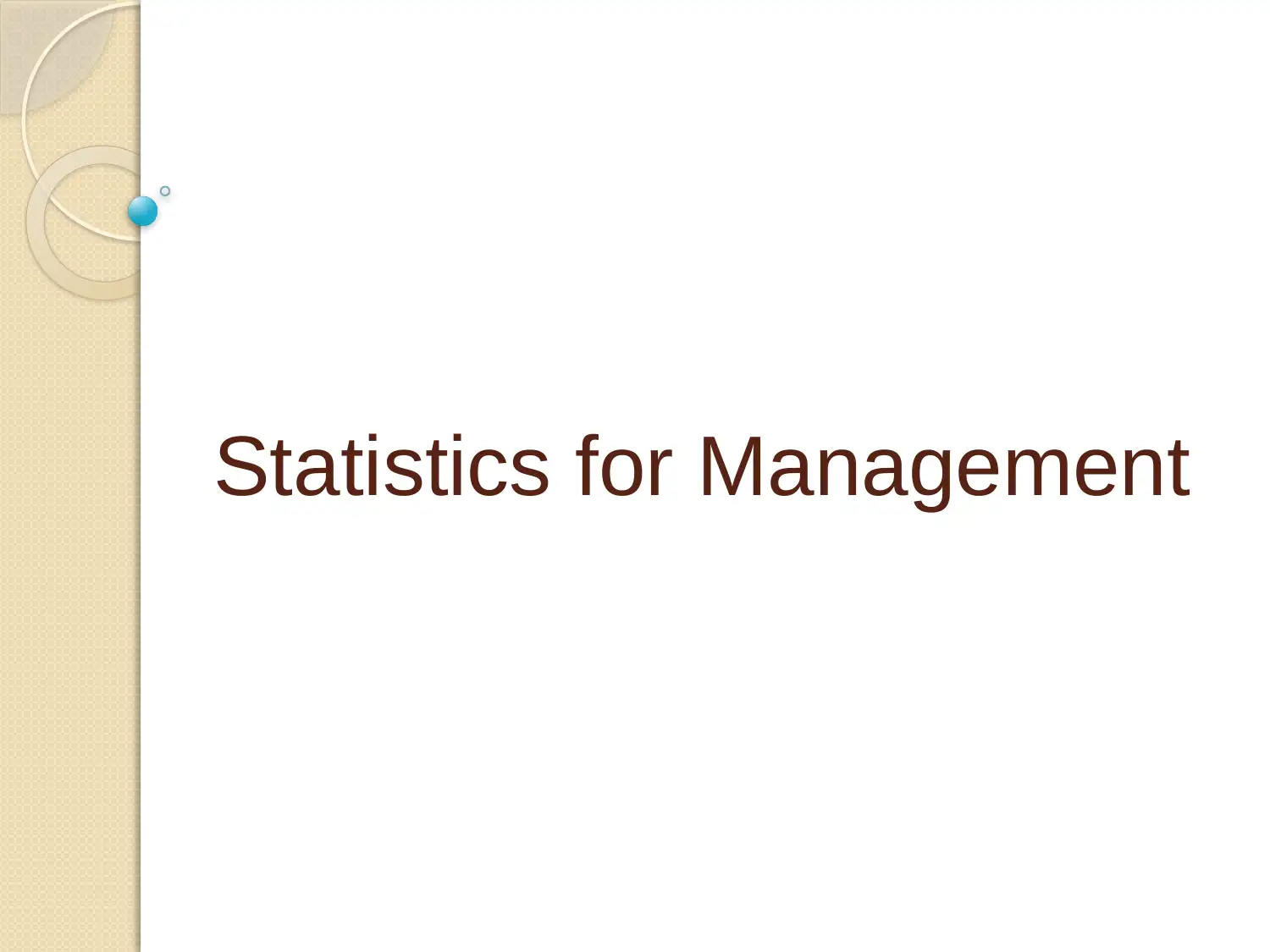
Statistics for Management
Paraphrase This Document
Need a fresh take? Get an instant paraphrase of this document with our AI Paraphraser
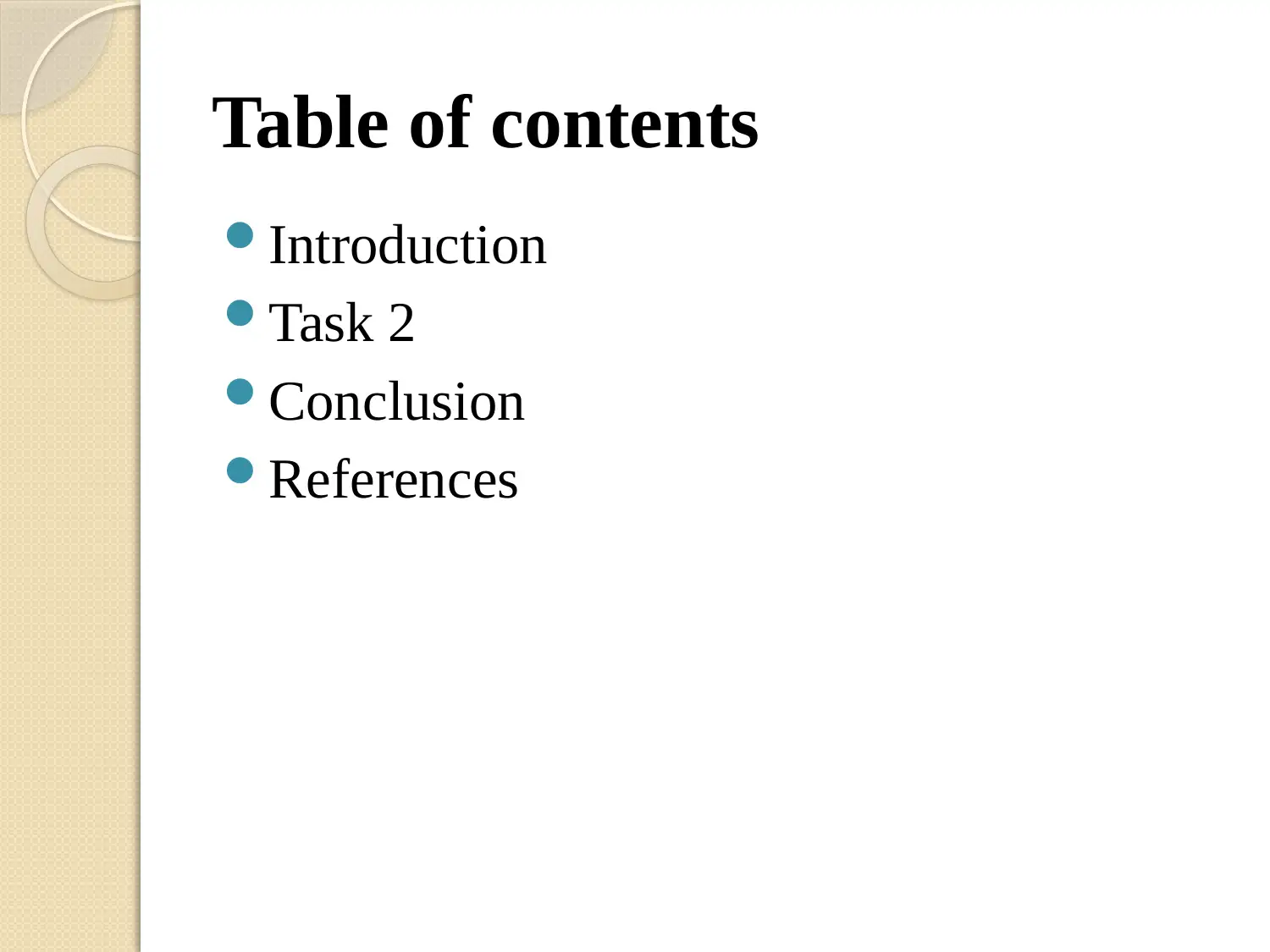
Table of contents
Introduction
Task 2
Conclusion
References
Introduction
Task 2
Conclusion
References
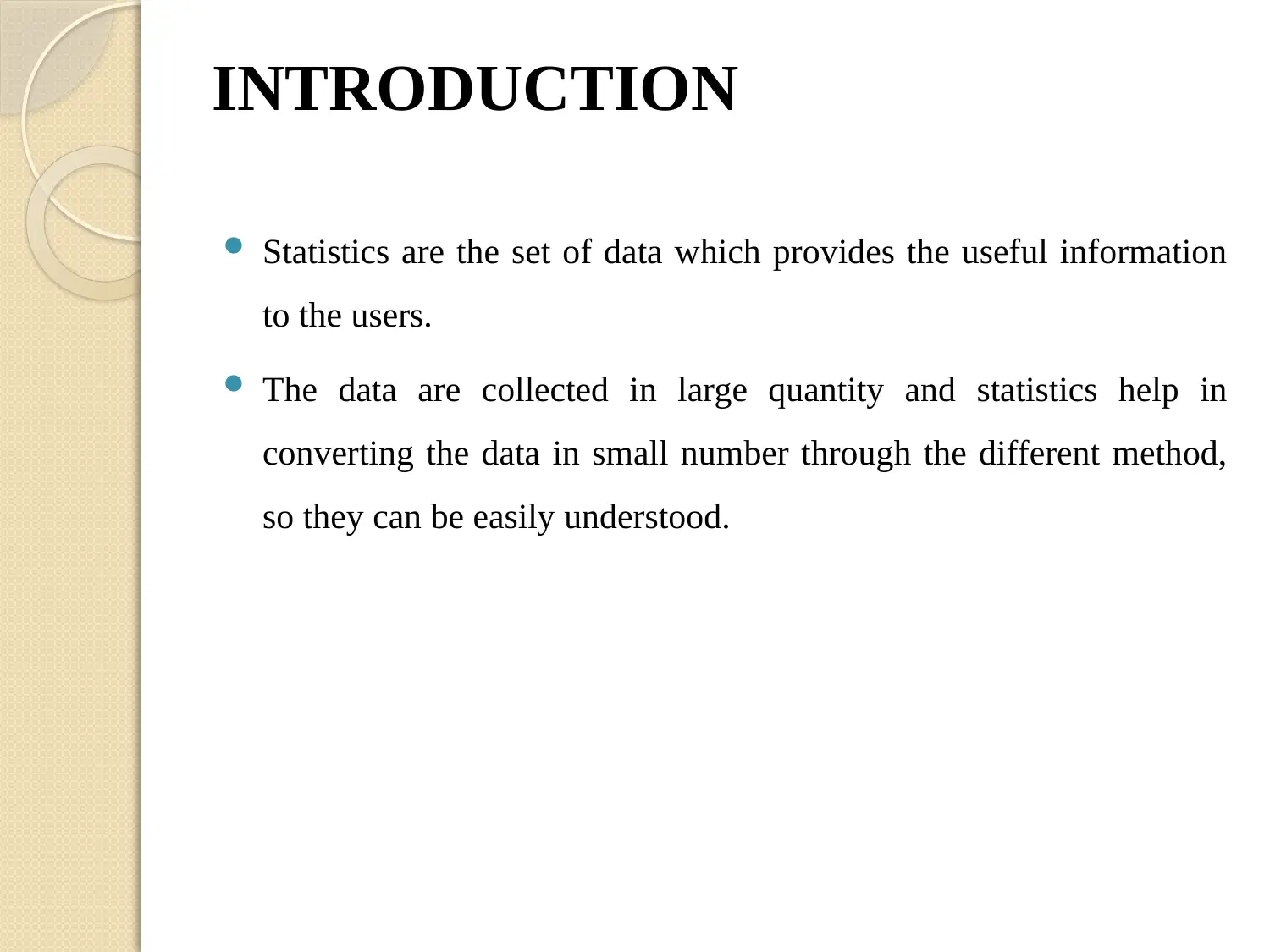
INTRODUCTION
Statistics are the set of data which provides the useful information
to the users.
The data are collected in large quantity and statistics help in
converting the data in small number through the different method,
so they can be easily understood.
Statistics are the set of data which provides the useful information
to the users.
The data are collected in large quantity and statistics help in
converting the data in small number through the different method,
so they can be easily understood.
You're viewing a preview
Unlock full access by subscribing today!
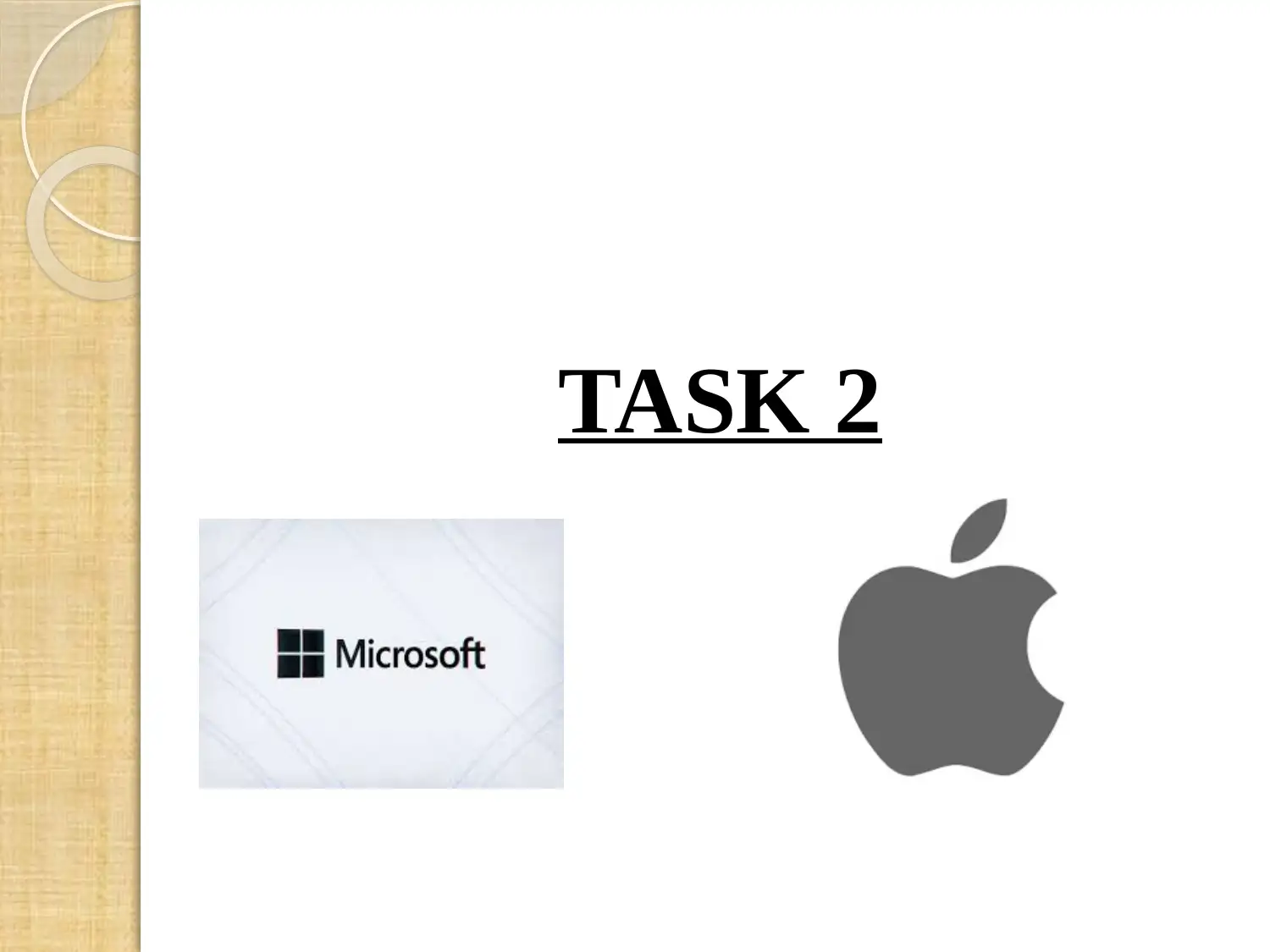
TASK 2
Paraphrase This Document
Need a fresh take? Get an instant paraphrase of this document with our AI Paraphraser
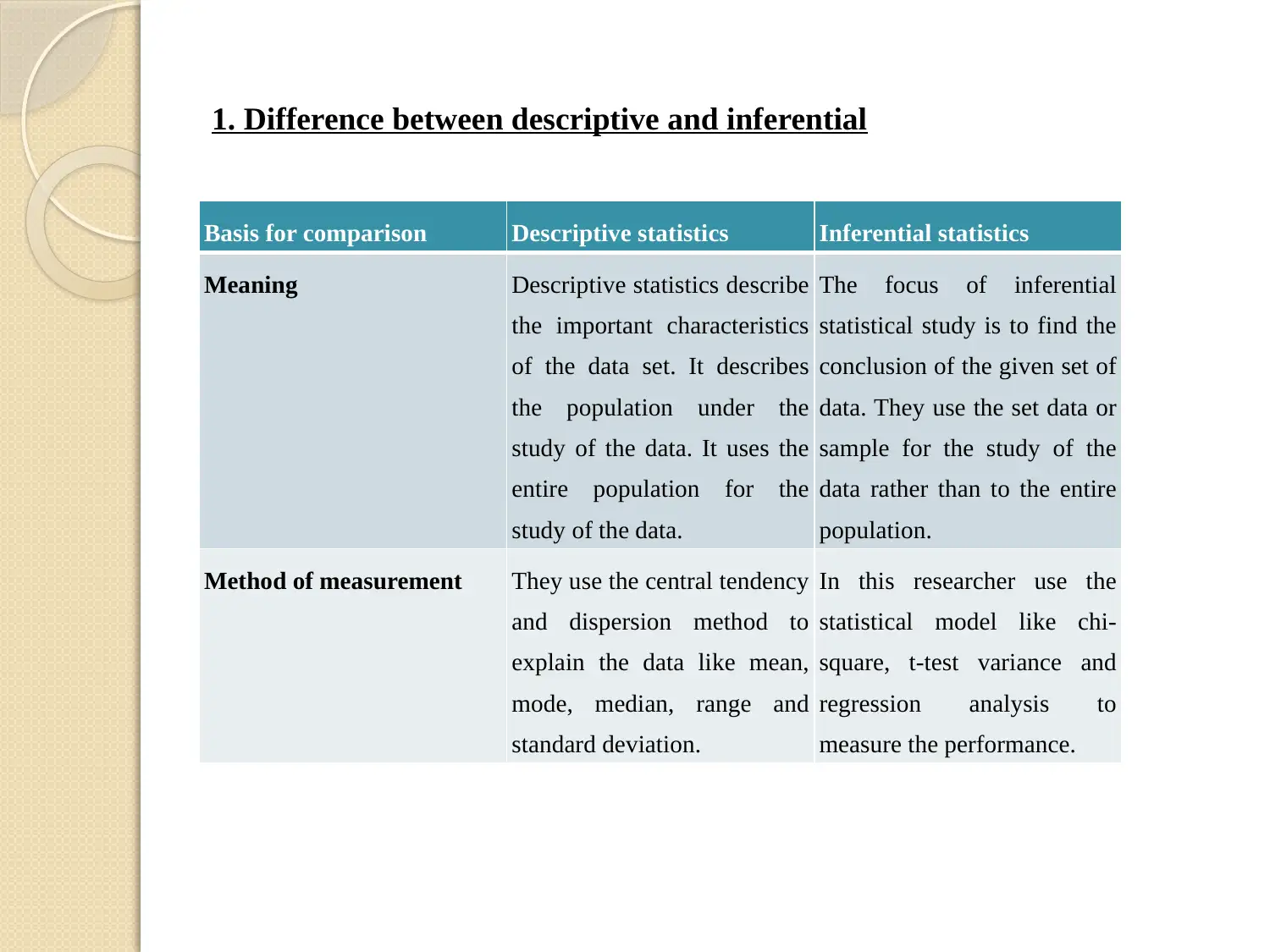
1. Difference between descriptive and inferential
Basis for comparison Descriptive statistics Inferential statistics
Meaning Descriptive statistics describe
the important characteristics
of the data set. It describes
the population under the
study of the data. It uses the
entire population for the
study of the data.
The focus of inferential
statistical study is to find the
conclusion of the given set of
data. They use the set data or
sample for the study of the
data rather than to the entire
population.
Method of measurement They use the central tendency
and dispersion method to
explain the data like mean,
mode, median, range and
standard deviation.
In this researcher use the
statistical model like chi-
square, t-test variance and
regression analysis to
measure the performance.
Basis for comparison Descriptive statistics Inferential statistics
Meaning Descriptive statistics describe
the important characteristics
of the data set. It describes
the population under the
study of the data. It uses the
entire population for the
study of the data.
The focus of inferential
statistical study is to find the
conclusion of the given set of
data. They use the set data or
sample for the study of the
data rather than to the entire
population.
Method of measurement They use the central tendency
and dispersion method to
explain the data like mean,
mode, median, range and
standard deviation.
In this researcher use the
statistical model like chi-
square, t-test variance and
regression analysis to
measure the performance.
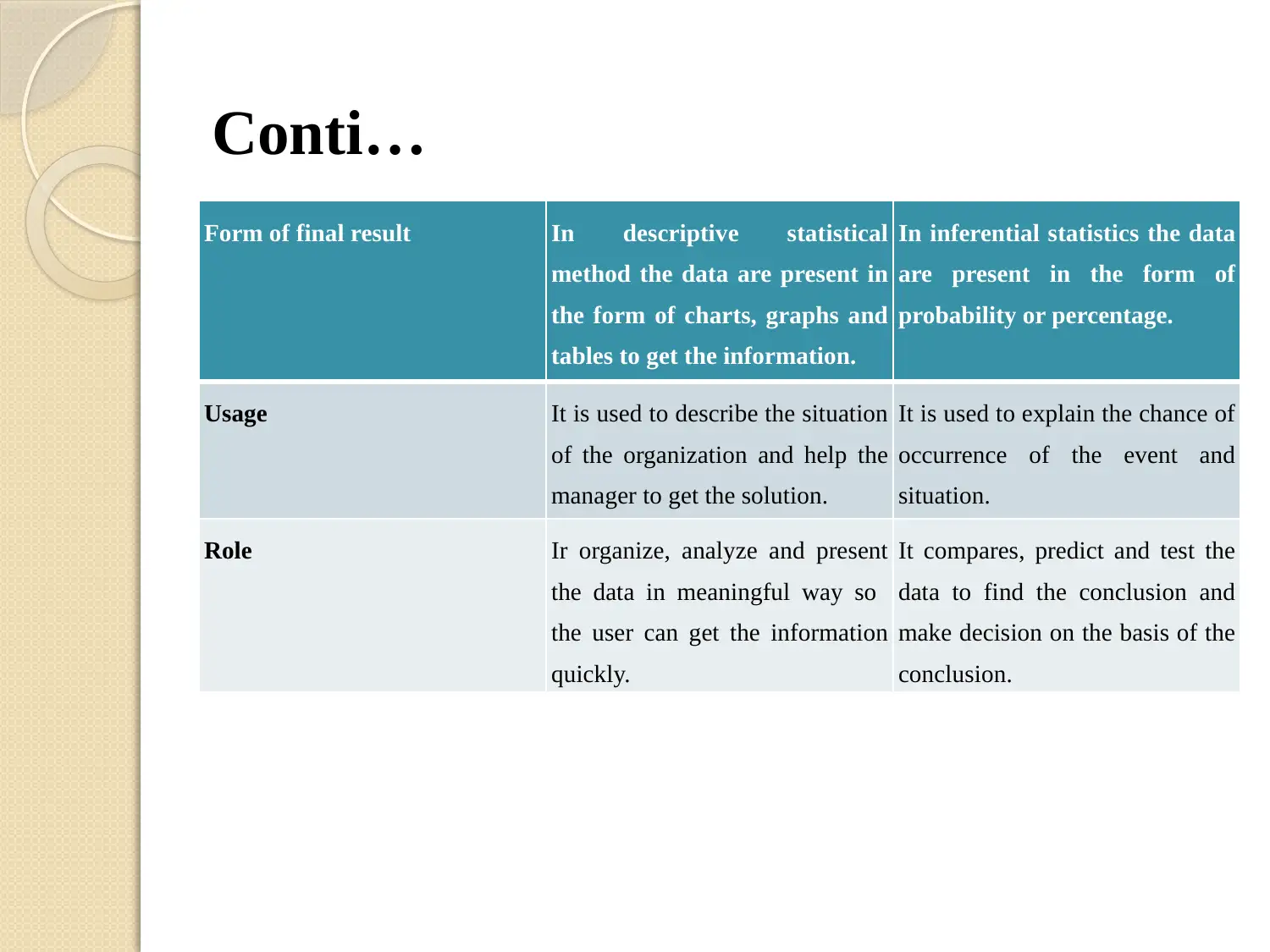
Conti…
Form of final result In descriptive statistical
method the data are present in
the form of charts, graphs and
tables to get the information.
In inferential statistics the data
are present in the form of
probability or percentage.
Usage It is used to describe the situation
of the organization and help the
manager to get the solution.
It is used to explain the chance of
occurrence of the event and
situation.
Role Ir organize, analyze and present
the data in meaningful way so
the user can get the information
quickly.
It compares, predict and test the
data to find the conclusion and
make decision on the basis of the
conclusion.
Form of final result In descriptive statistical
method the data are present in
the form of charts, graphs and
tables to get the information.
In inferential statistics the data
are present in the form of
probability or percentage.
Usage It is used to describe the situation
of the organization and help the
manager to get the solution.
It is used to explain the chance of
occurrence of the event and
situation.
Role Ir organize, analyze and present
the data in meaningful way so
the user can get the information
quickly.
It compares, predict and test the
data to find the conclusion and
make decision on the basis of the
conclusion.
You're viewing a preview
Unlock full access by subscribing today!
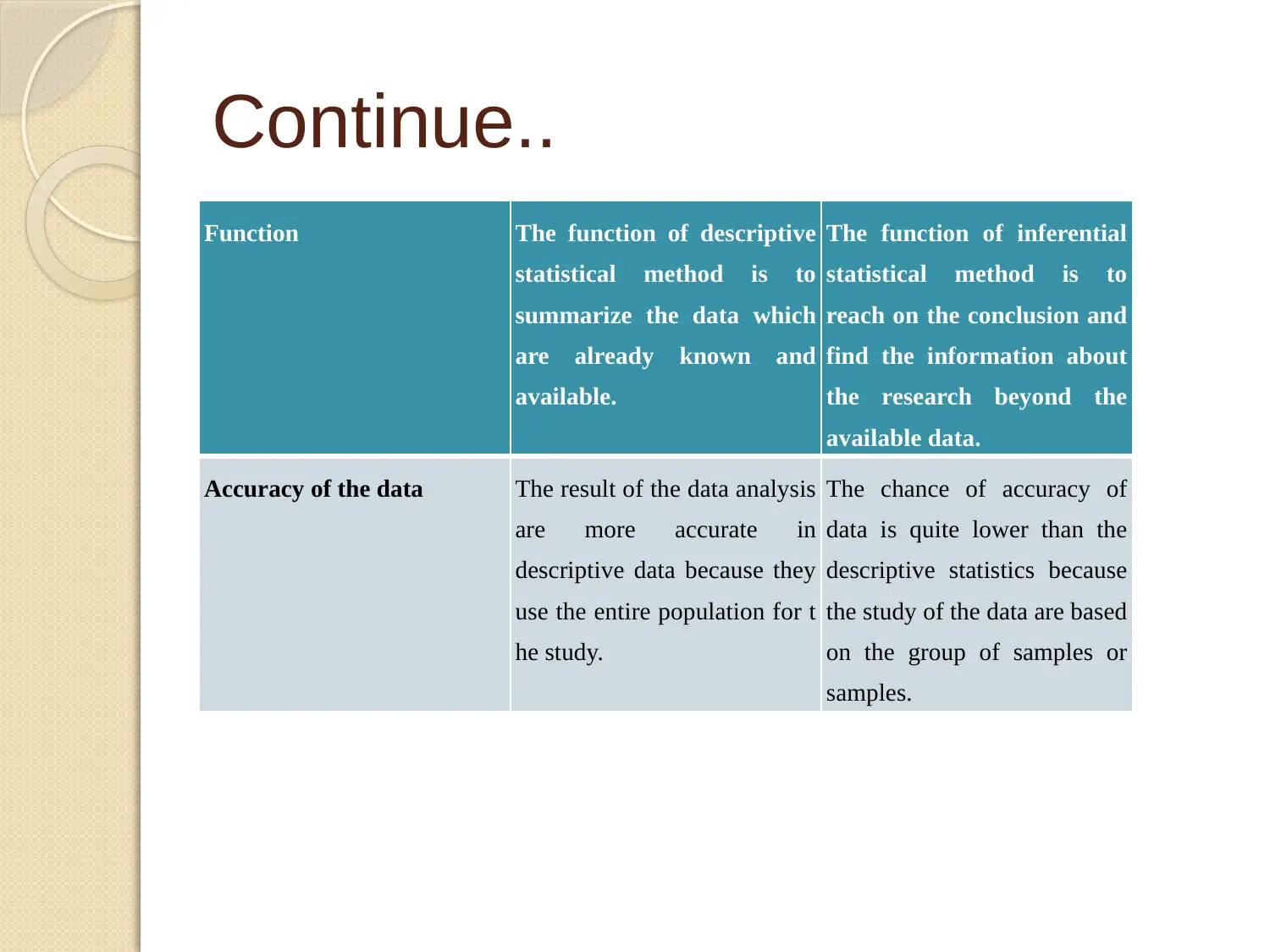
Continue..
Function The function of descriptive
statistical method is to
summarize the data which
are already known and
available.
The function of inferential
statistical method is to
reach on the conclusion and
find the information about
the research beyond the
available data.
Accuracy of the data The result of the data analysis
are more accurate in
descriptive data because they
use the entire population for t
he study.
The chance of accuracy of
data is quite lower than the
descriptive statistics because
the study of the data are based
on the group of samples or
samples.
Function The function of descriptive
statistical method is to
summarize the data which
are already known and
available.
The function of inferential
statistical method is to
reach on the conclusion and
find the information about
the research beyond the
available data.
Accuracy of the data The result of the data analysis
are more accurate in
descriptive data because they
use the entire population for t
he study.
The chance of accuracy of
data is quite lower than the
descriptive statistics because
the study of the data are based
on the group of samples or
samples.
Paraphrase This Document
Need a fresh take? Get an instant paraphrase of this document with our AI Paraphraser
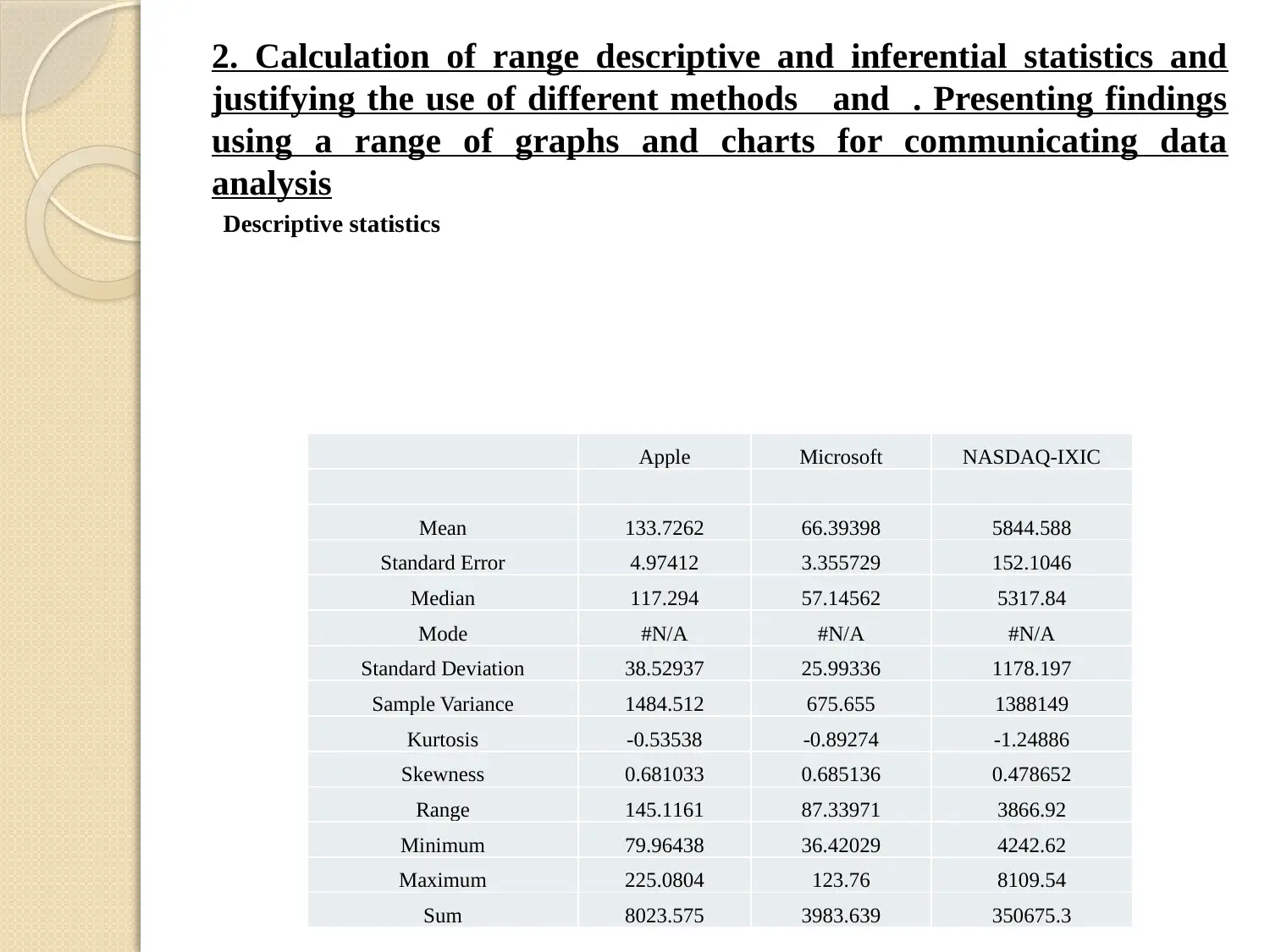
2. Calculation of range descriptive and inferential statistics and
justifying the use of different methods and . Presenting findings
using a range of graphs and charts for communicating data
analysis
Descriptive statistics
Apple Microsoft NASDAQ-IXIC
Mean 133.7262 66.39398 5844.588
Standard Error 4.97412 3.355729 152.1046
Median 117.294 57.14562 5317.84
Mode #N/A #N/A #N/A
Standard Deviation 38.52937 25.99336 1178.197
Sample Variance 1484.512 675.655 1388149
Kurtosis -0.53538 -0.89274 -1.24886
Skewness 0.681033 0.685136 0.478652
Range 145.1161 87.33971 3866.92
Minimum 79.96438 36.42029 4242.62
Maximum 225.0804 123.76 8109.54
Sum 8023.575 3983.639 350675.3
justifying the use of different methods and . Presenting findings
using a range of graphs and charts for communicating data
analysis
Descriptive statistics
Apple Microsoft NASDAQ-IXIC
Mean 133.7262 66.39398 5844.588
Standard Error 4.97412 3.355729 152.1046
Median 117.294 57.14562 5317.84
Mode #N/A #N/A #N/A
Standard Deviation 38.52937 25.99336 1178.197
Sample Variance 1484.512 675.655 1388149
Kurtosis -0.53538 -0.89274 -1.24886
Skewness 0.681033 0.685136 0.478652
Range 145.1161 87.33971 3866.92
Minimum 79.96438 36.42029 4242.62
Maximum 225.0804 123.76 8109.54
Sum 8023.575 3983.639 350675.3
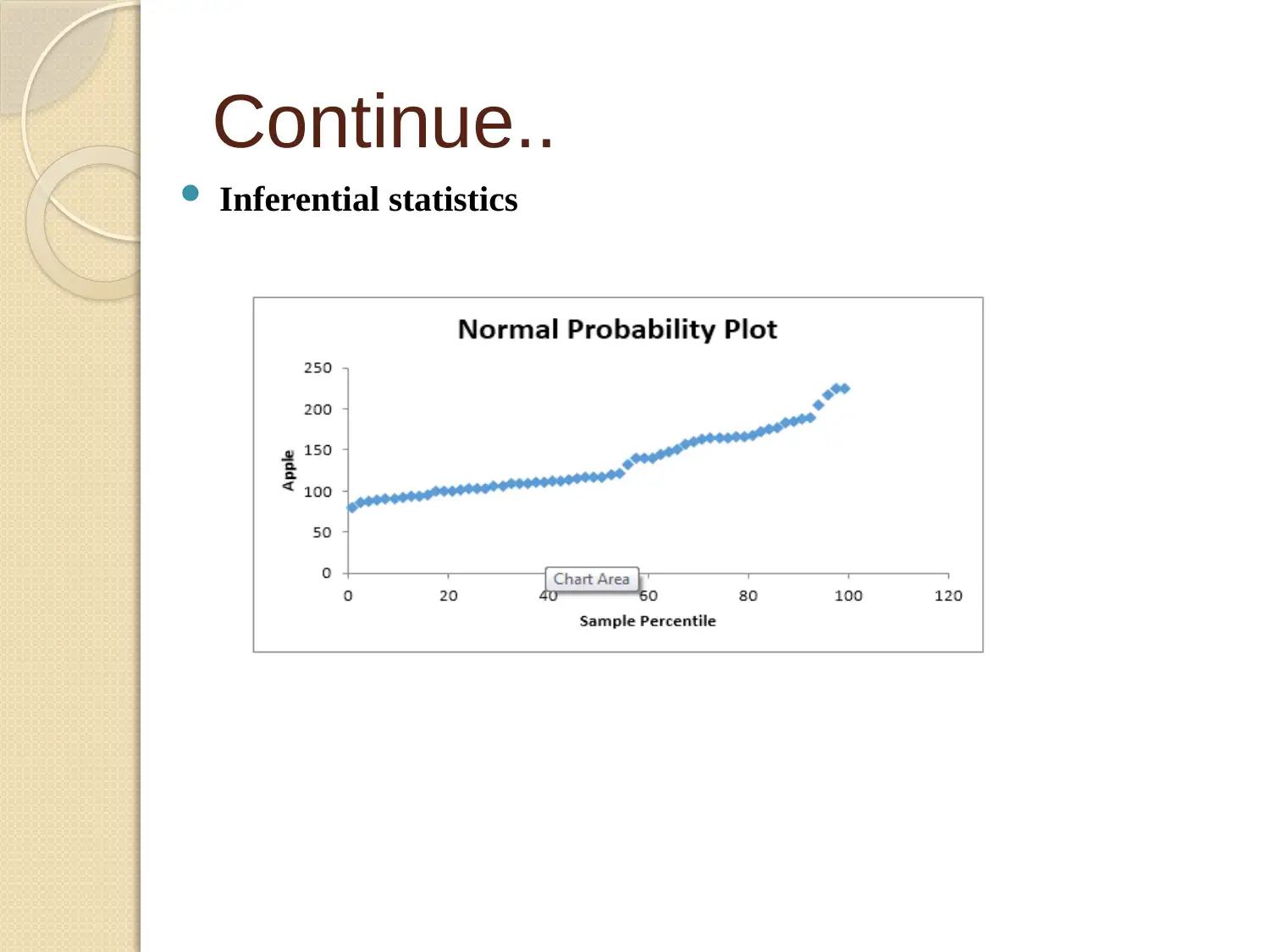
Continue..
Inferential statistics
Inferential statistics
You're viewing a preview
Unlock full access by subscribing today!
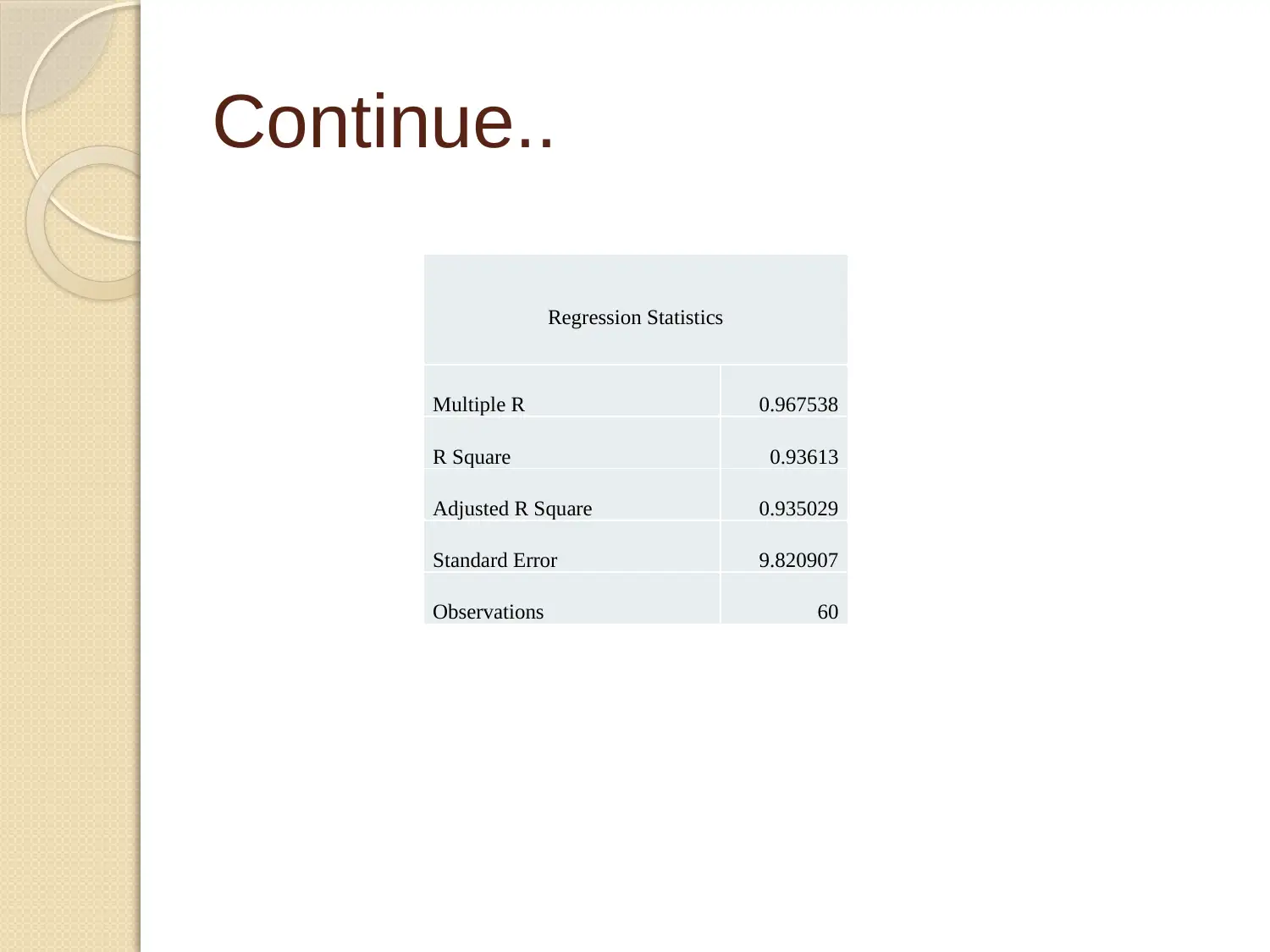
Continue..
Regression Statistics
Multiple R 0.967538
R Square 0.93613
Adjusted R Square 0.935029
Standard Error 9.820907
Observations 60
Regression Statistics
Multiple R 0.967538
R Square 0.93613
Adjusted R Square 0.935029
Standard Error 9.820907
Observations 60
Paraphrase This Document
Need a fresh take? Get an instant paraphrase of this document with our AI Paraphraser
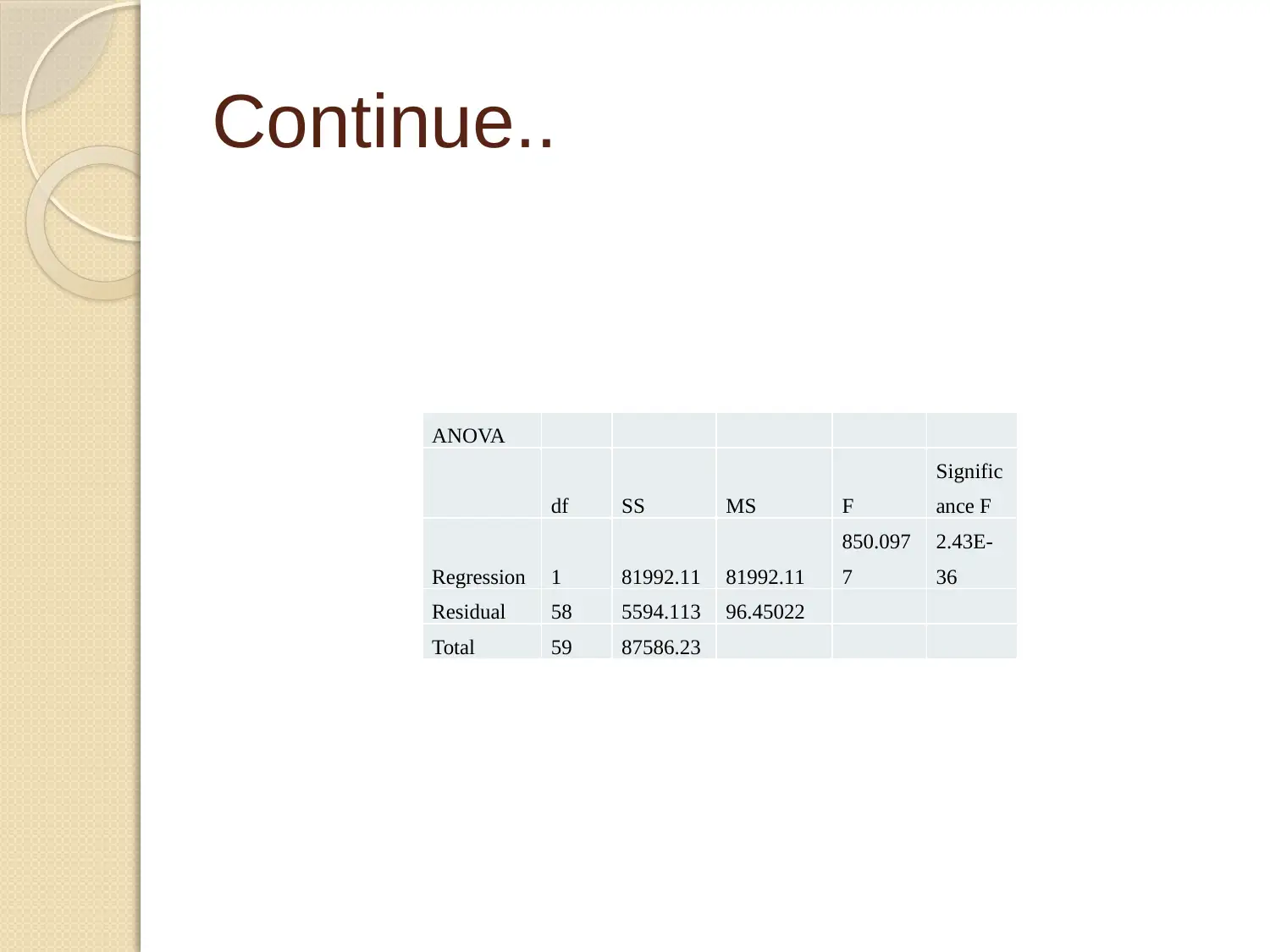
Continue..
ANOVA
df SS MS F
Signific
ance F
Regression 1 81992.11 81992.11
850.097
7
2.43E-
36
Residual 58 5594.113 96.45022
Total 59 87586.23
ANOVA
df SS MS F
Signific
ance F
Regression 1 81992.11 81992.11
850.097
7
2.43E-
36
Residual 58 5594.113 96.45022
Total 59 87586.23
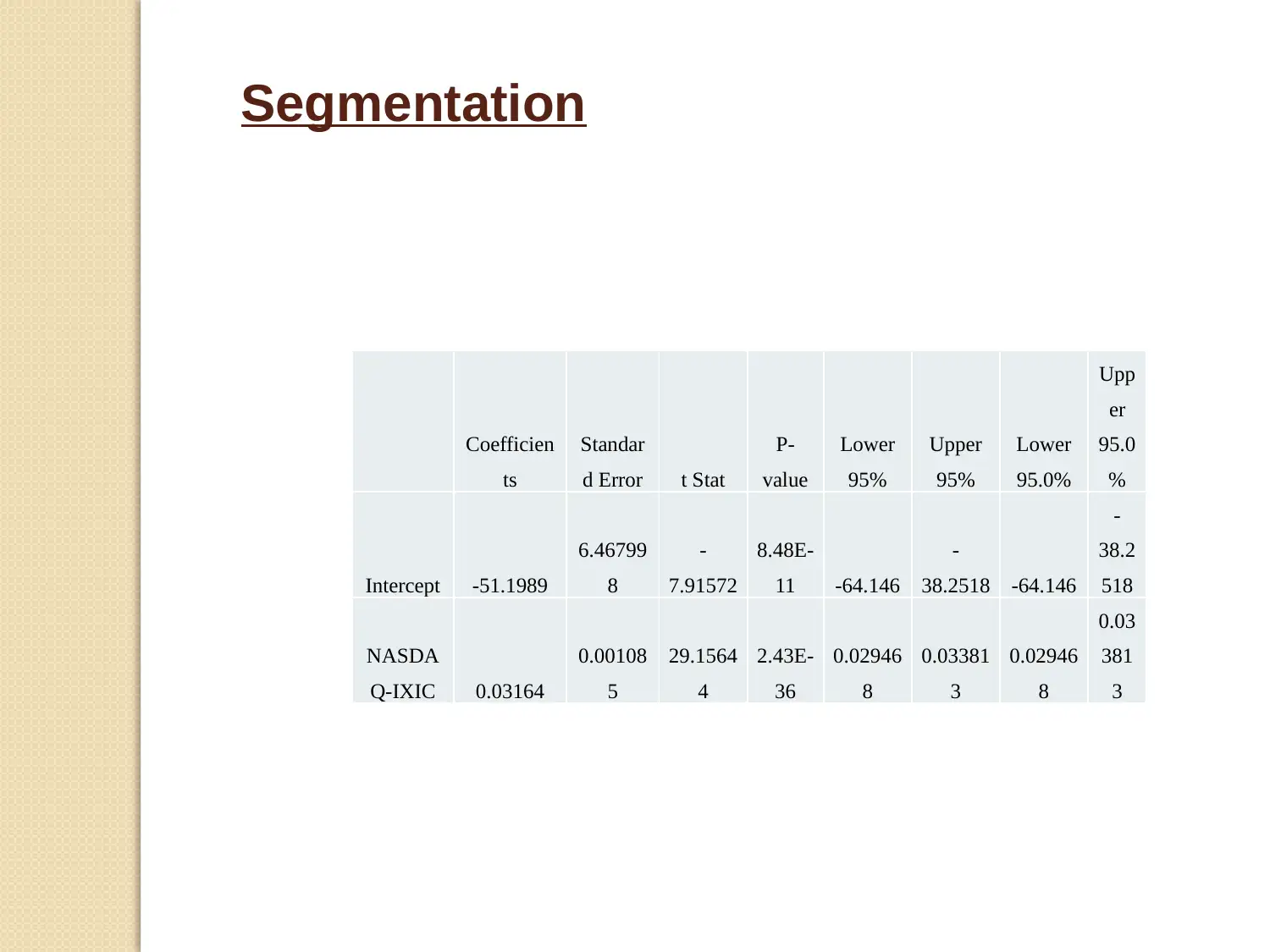
Segmentation
Coefficien
ts
Standar
d Error t Stat
P-
value
Lower
95%
Upper
95%
Lower
95.0%
Upp
er
95.0
%
Intercept -51.1989
6.46799
8
-
7.91572
8.48E-
11 -64.146
-
38.2518 -64.146
-
38.2
518
NASDA
Q-IXIC 0.03164
0.00108
5
29.1564
4
2.43E-
36
0.02946
8
0.03381
3
0.02946
8
0.03
381
3
Coefficien
ts
Standar
d Error t Stat
P-
value
Lower
95%
Upper
95%
Lower
95.0%
Upp
er
95.0
%
Intercept -51.1989
6.46799
8
-
7.91572
8.48E-
11 -64.146
-
38.2518 -64.146
-
38.2
518
NASDA
Q-IXIC 0.03164
0.00108
5
29.1564
4
2.43E-
36
0.02946
8
0.03381
3
0.02946
8
0.03
381
3
You're viewing a preview
Unlock full access by subscribing today!
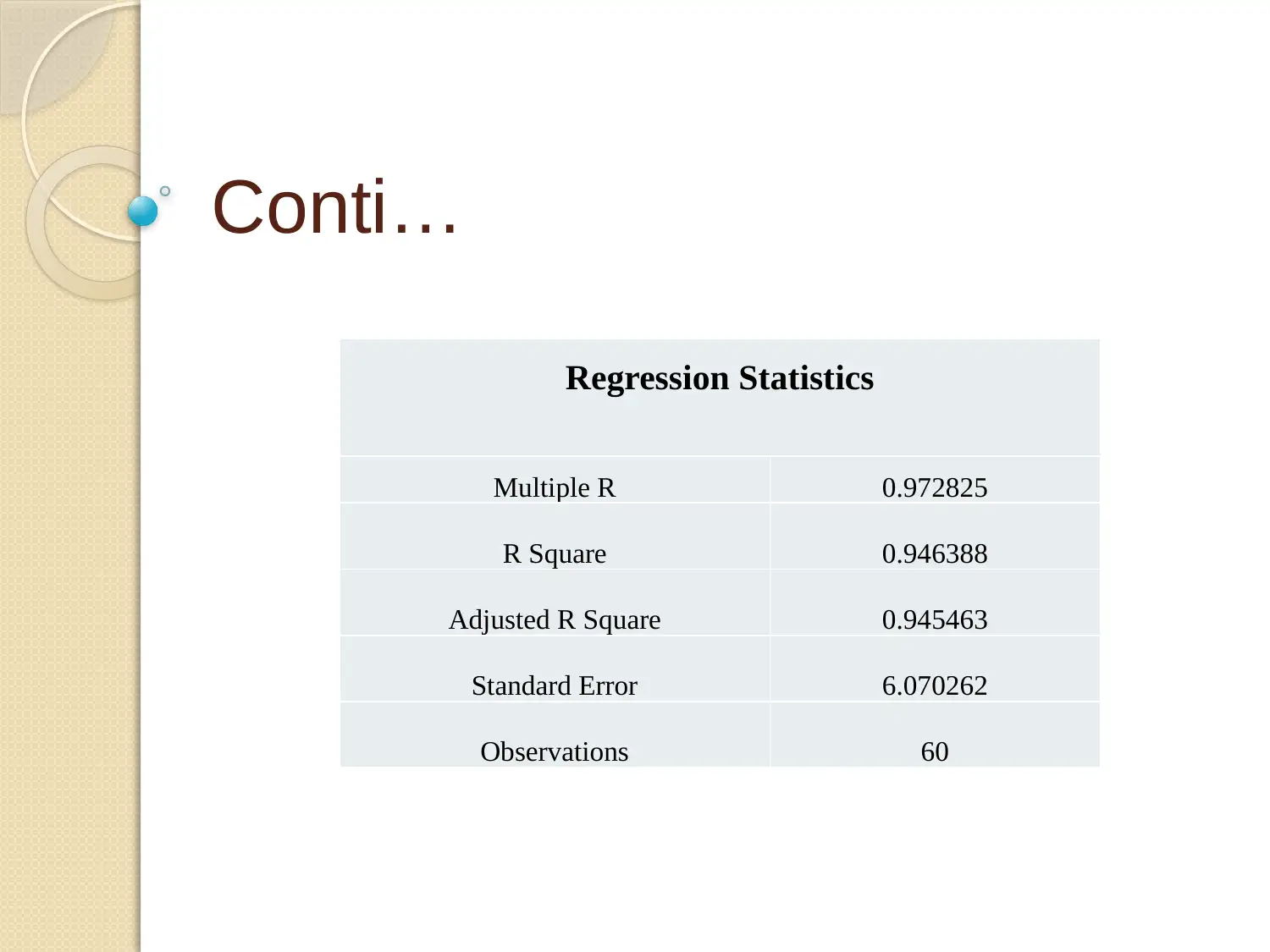
Conti…
Regression Statistics
Multiple R 0.972825
R Square 0.946388
Adjusted R Square 0.945463
Standard Error 6.070262
Observations 60
Regression Statistics
Multiple R 0.972825
R Square 0.946388
Adjusted R Square 0.945463
Standard Error 6.070262
Observations 60
Paraphrase This Document
Need a fresh take? Get an instant paraphrase of this document with our AI Paraphraser
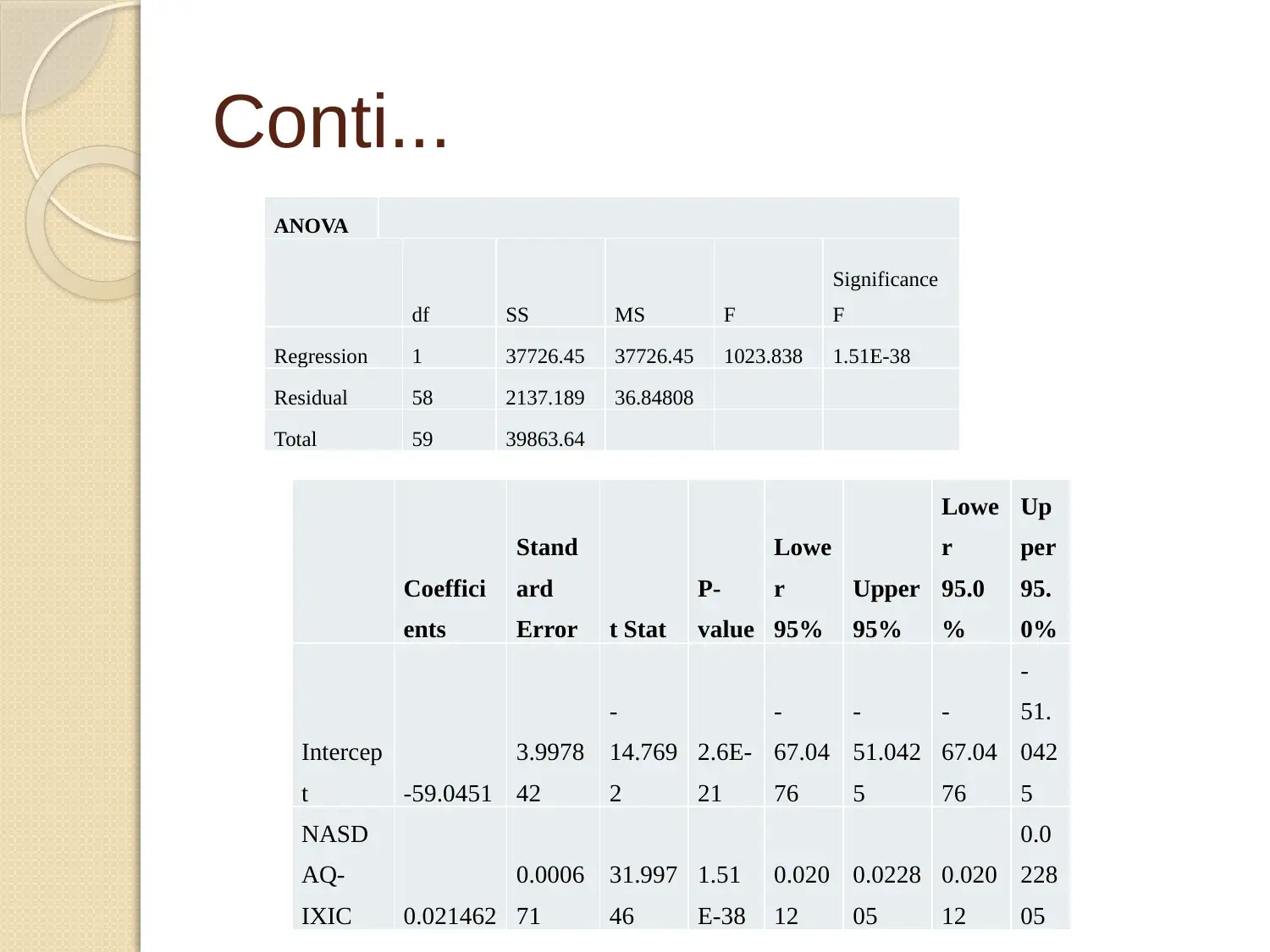
Conti...
ANOVA
df SS MS F
Significance
F
Regression 1 37726.45 37726.45 1023.838 1.51E-38
Residual 58 2137.189 36.84808
Total 59 39863.64
Coeffici
ents
Stand
ard
Error t Stat
P-
value
Lowe
r
95%
Upper
95%
Lowe
r
95.0
%
Up
per
95.
0%
Intercep
t -59.0451
3.9978
42
-
14.769
2
2.6E-
21
-
67.04
76
-
51.042
5
-
67.04
76
-
51.
042
5
NASD
AQ-
IXIC 0.021462
0.0006
71
31.997
46
1.51
E-38
0.020
12
0.0228
05
0.020
12
0.0
228
05
ANOVA
df SS MS F
Significance
F
Regression 1 37726.45 37726.45 1023.838 1.51E-38
Residual 58 2137.189 36.84808
Total 59 39863.64
Coeffici
ents
Stand
ard
Error t Stat
P-
value
Lowe
r
95%
Upper
95%
Lowe
r
95.0
%
Up
per
95.
0%
Intercep
t -59.0451
3.9978
42
-
14.769
2
2.6E-
21
-
67.04
76
-
51.042
5
-
67.04
76
-
51.
042
5
NASD
AQ-
IXIC 0.021462
0.0006
71
31.997
46
1.51
E-38
0.020
12
0.0228
05
0.020
12
0.0
228
05
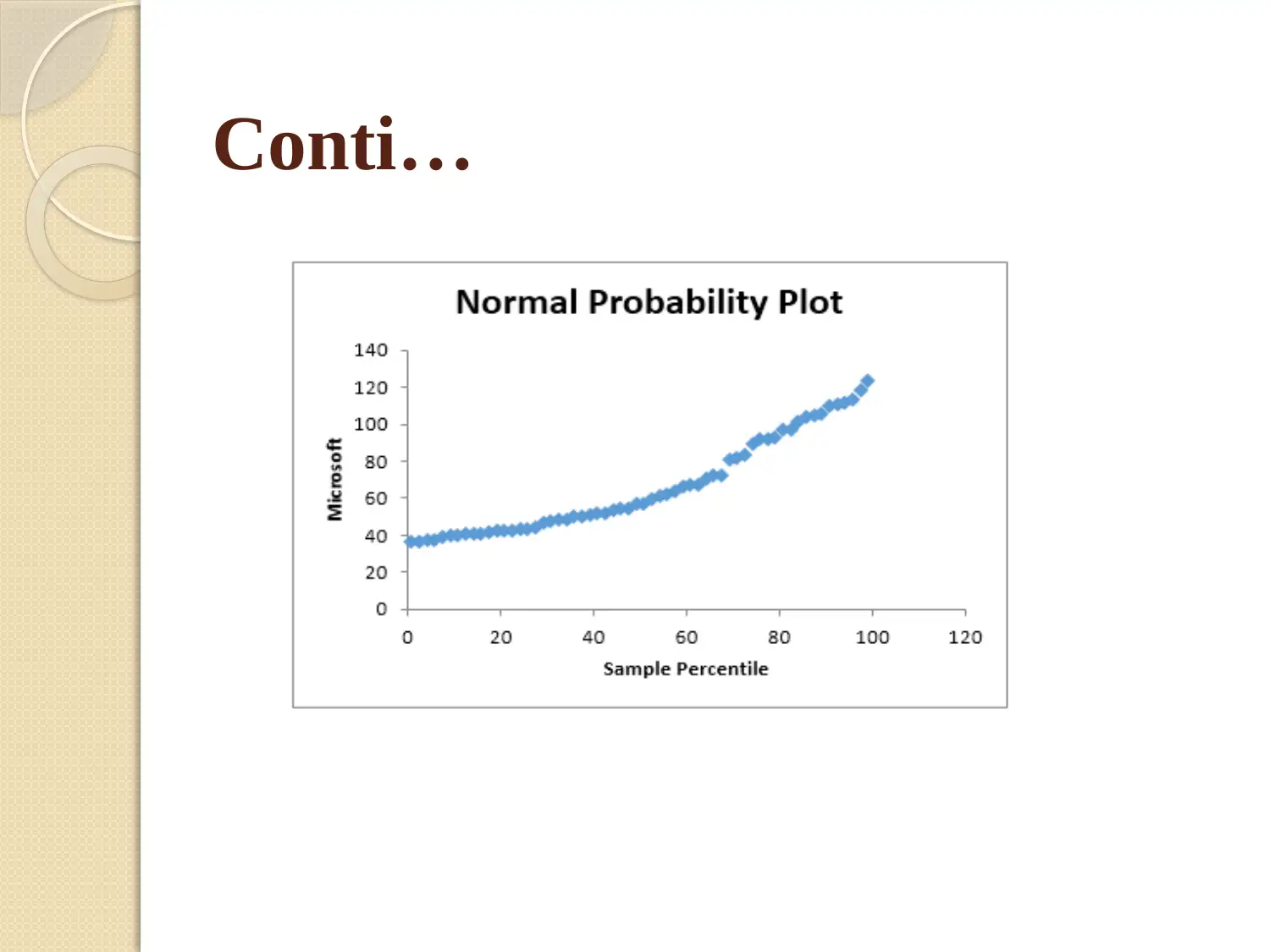
Conti…
You're viewing a preview
Unlock full access by subscribing today!
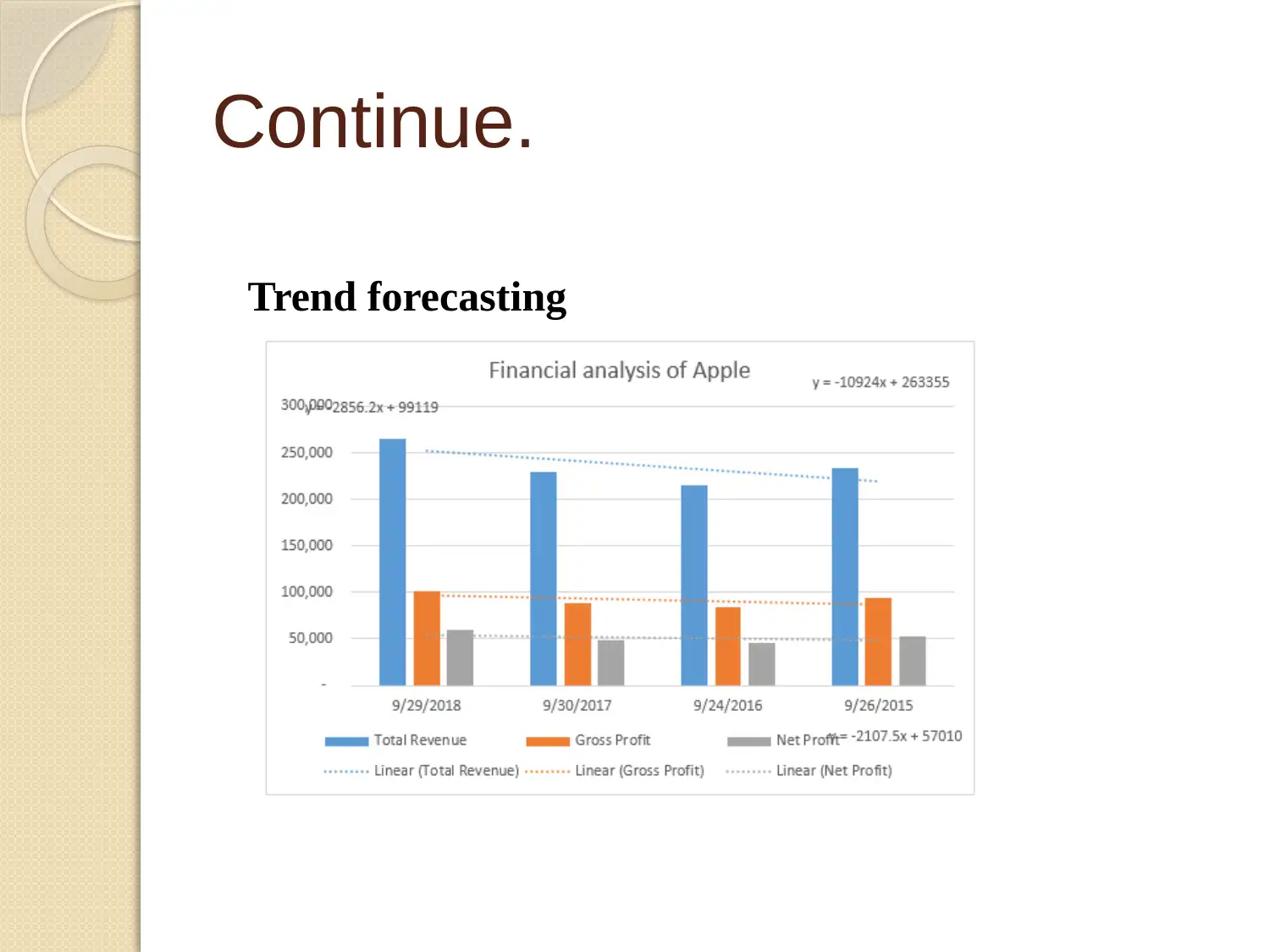
Continue.
Trend forecasting
Trend forecasting
Paraphrase This Document
Need a fresh take? Get an instant paraphrase of this document with our AI Paraphraser
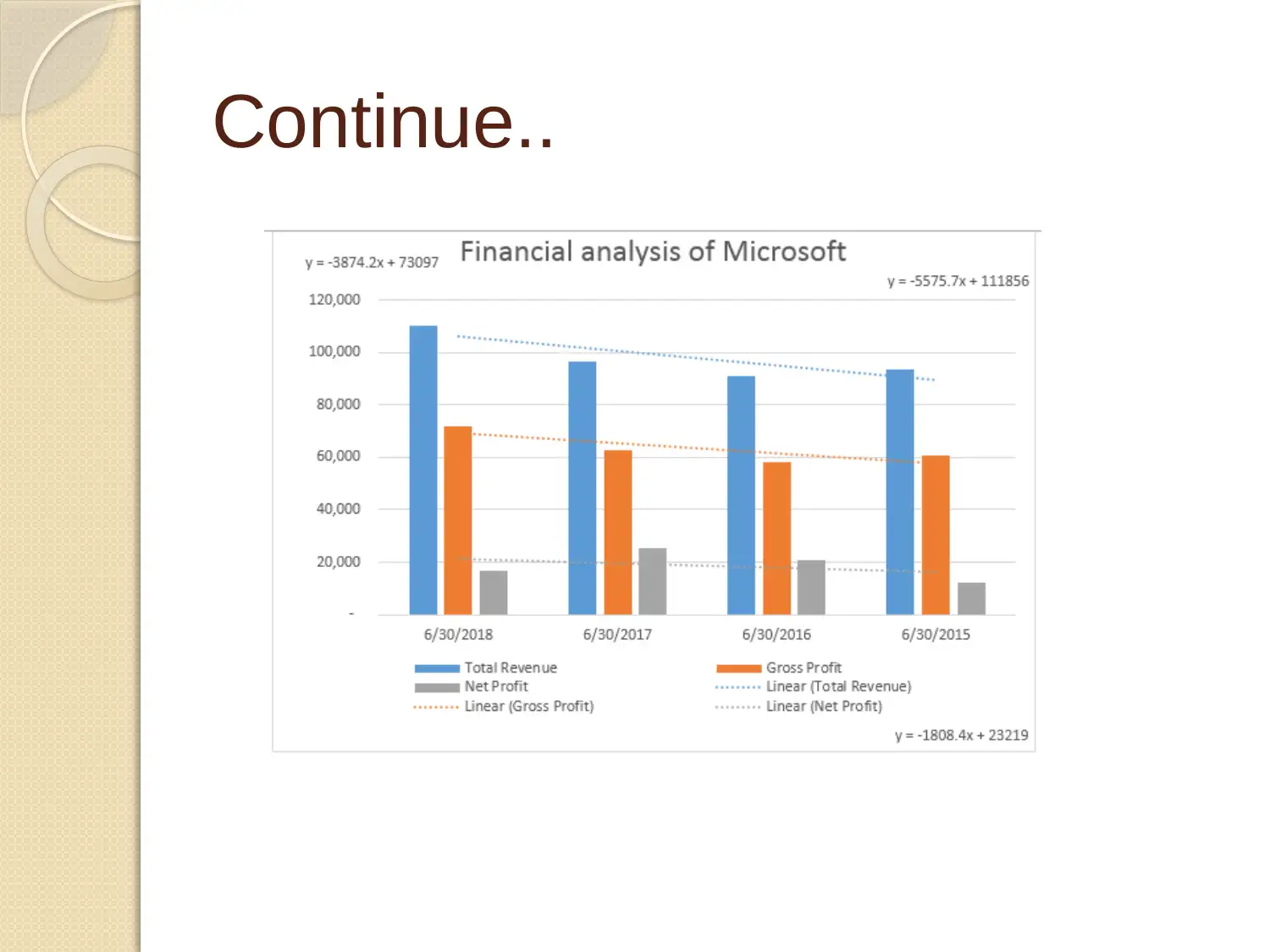
Continue..
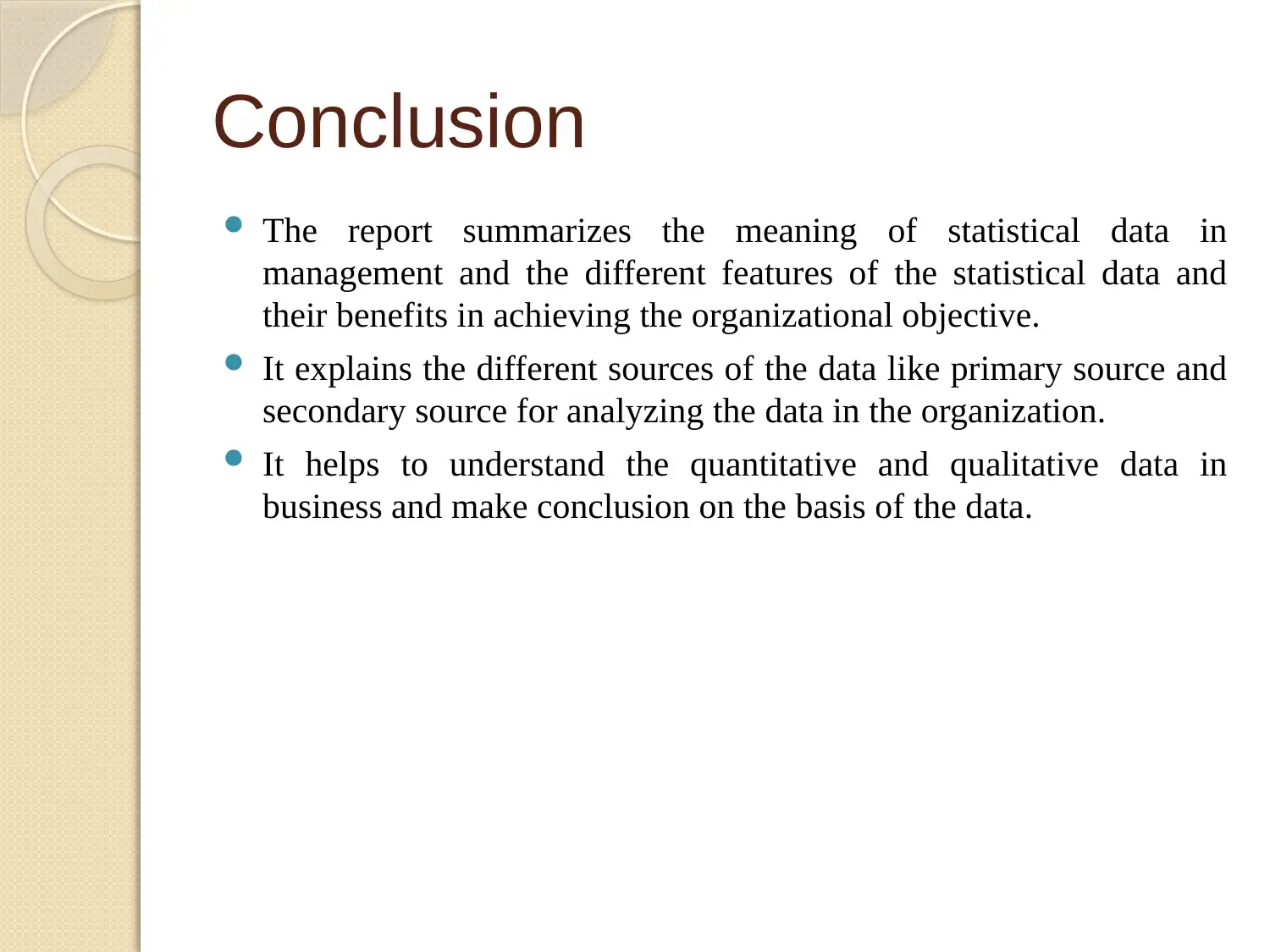
Conclusion
The report summarizes the meaning of statistical data in
management and the different features of the statistical data and
their benefits in achieving the organizational objective.
It explains the different sources of the data like primary source and
secondary source for analyzing the data in the organization.
It helps to understand the quantitative and qualitative data in
business and make conclusion on the basis of the data.
The report summarizes the meaning of statistical data in
management and the different features of the statistical data and
their benefits in achieving the organizational objective.
It explains the different sources of the data like primary source and
secondary source for analyzing the data in the organization.
It helps to understand the quantitative and qualitative data in
business and make conclusion on the basis of the data.
You're viewing a preview
Unlock full access by subscribing today!
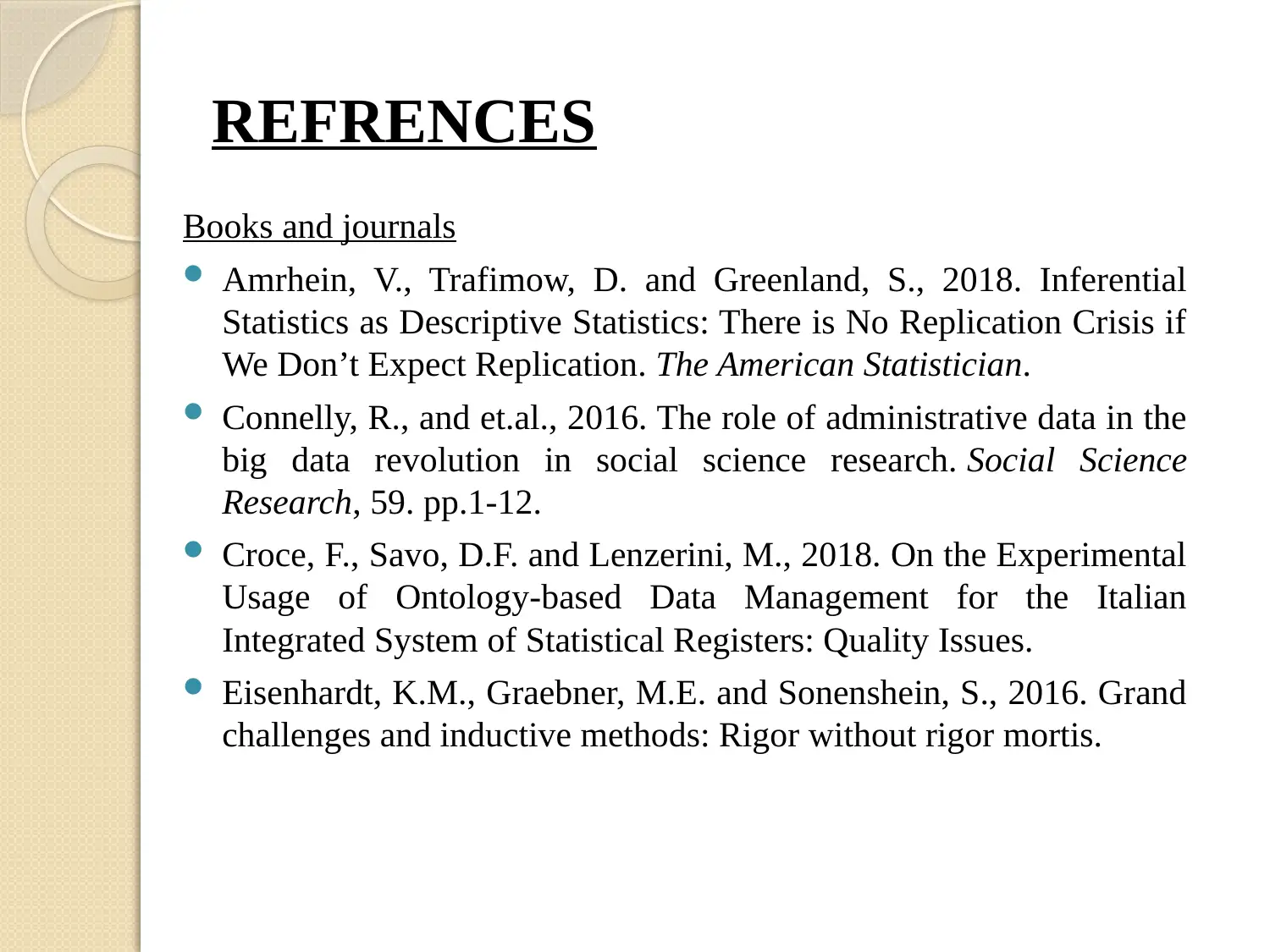
REFRENCES
Books and journals
Amrhein, V., Trafimow, D. and Greenland, S., 2018. Inferential
Statistics as Descriptive Statistics: There is No Replication Crisis if
We Don’t Expect Replication. The American Statistician.
Connelly, R., and et.al., 2016. The role of administrative data in the
big data revolution in social science research. Social Science
Research, 59. pp.1-12.
Croce, F., Savo, D.F. and Lenzerini, M., 2018. On the Experimental
Usage of Ontology-based Data Management for the Italian
Integrated System of Statistical Registers: Quality Issues.
Eisenhardt, K.M., Graebner, M.E. and Sonenshein, S., 2016. Grand
challenges and inductive methods: Rigor without rigor mortis.
Books and journals
Amrhein, V., Trafimow, D. and Greenland, S., 2018. Inferential
Statistics as Descriptive Statistics: There is No Replication Crisis if
We Don’t Expect Replication. The American Statistician.
Connelly, R., and et.al., 2016. The role of administrative data in the
big data revolution in social science research. Social Science
Research, 59. pp.1-12.
Croce, F., Savo, D.F. and Lenzerini, M., 2018. On the Experimental
Usage of Ontology-based Data Management for the Italian
Integrated System of Statistical Registers: Quality Issues.
Eisenhardt, K.M., Graebner, M.E. and Sonenshein, S., 2016. Grand
challenges and inductive methods: Rigor without rigor mortis.
Paraphrase This Document
Need a fresh take? Get an instant paraphrase of this document with our AI Paraphraser

THANK YOU
1 out of 20
Related Documents
Your All-in-One AI-Powered Toolkit for Academic Success.
+13062052269
info@desklib.com
Available 24*7 on WhatsApp / Email
![[object Object]](/_next/static/media/star-bottom.7253800d.svg)
Unlock your academic potential
© 2024 | Zucol Services PVT LTD | All rights reserved.




